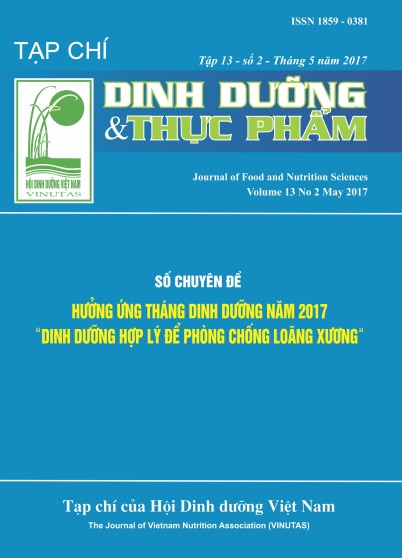PREVALENCE AND ASSOCIATED FACTORS OF ANAEMIA AMONG MALNOURISHED AND OVERWEIGHT AND OBESE CHILDREN AGED 6-9 YEARS OLD IN 8 PRIMARY SCHOOLS IN RURAL AREAS IN HAI PHONG CITY IN 2016
Main Article Content
Abstract
In developing countries where are currently experiencing the double burden of diseases, not only malnourished children but also overweight and obese children are suffered from anemia. Objectives: To determine the prevalence and associated factors of anemia among malnourished and overweight and obese children aged 6-9 years old in 8 primary schools in rural areas in Hai Phong City. Methodology: A cross sectional study was conducted to screen for anthropometry on 2,866 children, analyse haemoglobin concentration of 892 children and interview parents/primary caregivers of the children took part blood examination in October 2016. Results: Prevalence of anemia among underweight, stunted, and wasted children were 29.3%, 28.3% and 29.6%, respectively. Odds for anemia of malnourished children were twice compared with non-malnutrition children (p<0.05). Prevalence of anemia among overweight and obese children was 8.8% and 7.9%, respectively. Risks for overweight and obese children being anemic were less than for normal weight children by 45% and 44% (p<0.05), respectively. No statistically significant difference was detected for the relationships between anemia and mothers’ education level and occupation, and monthly household income.
Keywords
Anemia, schoolchildren, malnutrition, overweight, obesity
Article Details
References
2. Ngui, R., Lim, Y.A.L., Chong Kin, L., Sek Chuen, C., et al (2012). Association between Anaemia, Iron Deficiency Anaemia, Neglected Parasitic Infections and Socioeconomic Factors in Rural Children of West Malaysia. PLoS Neglected Tropical Diseases. 6(3): e1550.
3. Rasha Aziz, S., and Meray, R.L.(2016). The Prevalence of anemia among informal primary school children: a community based study in Rural Upper Egypt. Epidemiology, Biostatistics and Public Health.13(1).
4. Le Thi Huong, Brouwer, I.D., Verhoef, H., Nguyen Cong Khan et al (2007). Anemia and intestinal parasite infection in school children in rural Vietnam. APJCN. 16(4): 716-723.
5. Le Nguyen Bao Khanh, Le Thi Hop, Nguyen Do Van Anh, Tran Thuy Nga et al.(2013). Double burden of undernutrition and overnutrition in Vietnam in 2011: results of the SEANUTS study in 0•5–11-year-old children. British J of Nutr. 110(Suppl3): S45-S56.
6. Viện Dinh dưỡng. (2011). Tình hình thiếu vi chất và kế hoạch hành động về tăng cường vi chất vào bột mì ở Việt Nam. Truy cập ngày 07/7/2015 từ: http://www.viendinhduong.vn/news/vi/194/0/tinh-hinhthieu-vi-chat-va-ke-hoach-hanh-dong-ve-tang-cuong-vi-chat-vao-bot-my-o-vietnam.aspx.
7. Manios, Y., Moschonis, G., Chrousos, G. P., Lionis, C., et al (2013). The double burden of obesity and iron deficiency on children and adolescents in Greece: the Healthy Growth Study. J of Human Nutr & Dietetics. 26(5): 470-4789.
8. Zhao, L., Zhang, X., Shen, Y., Fang, X., et al (2015). Obesity and iron deficiency: a quantitative meta-analysis. Obe Rev. 16(12): 1081-1093.
9. Hoàng Thị Đức Ngàn, Lê Thị Hợp, Cao Thị Thu Hương, Vũ Đức Hưởng (2014). Mối liên quan tiêu thụ thực phẩm, hoạt động thể lực với thừa cân, béo phì ở trẻ em tiểu học và tác động của các yếu tố kinh tế xã hội. Tạp chí DD&TP. 10(1): 7-13.
10.Hoàng Thị Đức Ngàn và Lê Thị Hợp (2012). Tỷ lệ TC-BP và một số yếu tố liên quan của trẻ em tại một số trường tiểu học tại Hải Phòng năm 2012. Báo cáo nghiệm thu đề tài. Viện Dinh dưỡng: Hà Nội.
11.Stoltzfus, R.J., Chwaya, H.M., Tielsch, J.M., Schulze, K.J., et al.(1997). Epidemiology of iron deficiency anemia in Zanzibari schoolchildren: the importance of hookworms. The AJCN. 65(1):153-9.


